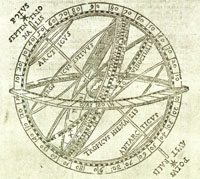Sacrobosco and the Armillary Sphere
Sacrobosco's treatise De Sphaera (or De Spera etc.) does not refer to an armillary sphere at any point, although use of another astronomical instrument, the astrolabe, is explicitly mentioned. Nevertheless, the association between the text and the demonstrational armillary sphere is extremely strong. The work was the most widely used astronomical text of the late middle-ages and early-modern period; first printed in 1472, there were more than 30 incunabula editions and over two hundred in the sixteenth century. Furthermore, the tradition of commenting upon the text extends from near-contemporaries of Sacrobosco to the likes of the Jesuit astronomer Christoph Clavius (1538-1612), whosecommentaries, published from 1570 onwards in several editions, eventually ran to over 800 pages.
 An image of an armillary sphere, from Clavius's commentary on De Sphaera.
An image of an armillary sphere, from Clavius's commentary on De Sphaera.
The text is divided into four chapters. The first discusses the general structure of the universe, the second the circles of the celestial sphere, the third the daily rotation of the heavens and the climates of the Earth, and the fourth planetary movements and eclipses. In those manuscripts which contain diagrams, planar representations adequately indicate the nature of such phenomena as eclipses. But for an understanding of the three-dimensionality of the universe and the divisions of the celestial sphere, that is the colures, tropics, equator, polar circles, ecliptic, and zodiac, students would have required some kind of demonstrational model. The congruence between the text of De Sphaera, particularly the chapter on the celestial circles, and the form of the basic demonstrational armillary is notable; perhaps the use of such armillaries was as widespread as that of the text itself. Images of armillary spheres are certainly common in printed copies of De Sphaera, and it is interesting that, even after illustrators had developed the techniques for representing three-dimensionality, diagrams of the celestial sphere are often given in the form of an armillary rather than a simple schematic. The image shown here comes from the 3rd edition (Rome, 1581) of Clavius' In sphaeram Iohannis de Sacro Bosco commentarius.
Chapter 1 of De Sphaera defines a sphere geometrically, gives reasons for asserting that both the universe and the Earth are spherical, and discusses the difference between its ethereal and elemental (or sublunary) regions. Nine concentric heavenly spheres are named: in order of increasing distance from the Earth, that of the Moon, of Mercury, of Venus, the Sun, Mars, Jupiter, Saturn, the sphere of the fixed stars and the primum mobile. To the latter is attributed the daily rotation of all the heavenly bodies about the poles of the equator. An individual motion, in the opposite direction and about the poles of the ecliptic, is attributed to the separate planetary spheres, and Sacrobosco states their periods of rotation. In discussing the size of the Earth, he gives its circumference as 252 000 stades according to Ambrose, Theodosius, and Eratosthenes, and describes how this can be confirmed by using an astrolabe to determine an interval of one degree of terrestrial latitude.
In Chapter 2, Sacrobosco names and defines the various celestial circles: the equinoctial (or celestial equator); the zodiac; the ecliptic (the apparent annual path of the Sun around the Earth, 6° to either side of which extends the Zodiac); the meridian; the horizon; the Tropics of Cancer and Capricorn; the solstitial and equinoctial colures (great circles passing through the celestial poles and the points in the ecliptic corresponding to the solstices and equinoxes); and the Arctic and Antarctic circles. The chapter also includes etymological speculations about the names of such words as "arctic", "boreal", and "zodiac", lists the twelve zodiac signs in order, and introduces the concept of latitude in terms of the elevation of the pole above the horizon. The final section of the chapter discusses the fives zones of the world demarcated by the arctic, antarctic, and tropical circles, and the tropical and polar regions are said to be uninhabitable.
In Chapter 3, Sacrobosco discusses the categories of rising and setting of the stars constellations, for example heliacal rising (when a body first becomes visible before dawn after a period when it has been obscured by the Sun), with reference to the verses of Ovid, Virgil and Lucan. He describes the annual motion of the Sun, as seen from the differing terrestrial zones, and the variation in the duration of daylight throughout the year. And he discusses the division of the habitable temperate zone of the Earth into the seven climes or regions which are often represented on the "latitude" plates of medieval Islamic and European astrolabes.
In the final chapter of De Sphaera, Sacrobosco is concerned with the movements of the heavenly bodies. He discusses the movement of the Sun in the ecliptic, and describes the solar years as 365 1/4 days, except for a small fraction which is imperceptible.
He states that the course of all the other planets can be broken down into three circles: an equant (concentric with the earth, and in the plane of the ecliptic), a deferent (an eccentric intersecting the plane of the ecliptic), and an epicycle (a small circle centred on the circumference of the deferent), and defines their direct and retrograde motions and stations. However, no detail is provided. The causes of lunar and solar eclipses are explained, and Sacrobosco ends by noting that the solar eclipse which occurred at the time of Christ's Passion must have been miraculous, since it occurred at Full Moon.